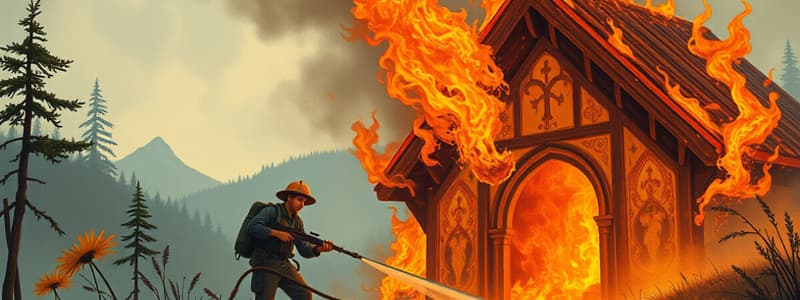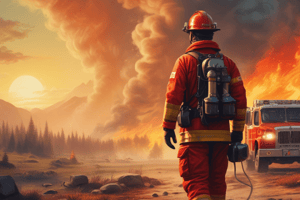Podcast
Questions and Answers
How many feet are in a chain?
How many feet are in a chain?
66 feet
Name the 3 sides of the fire triangle.
Name the 3 sides of the fire triangle.
Oxygen, Fuel, Heat
How does conduction supply heat to a fuel to start a fire?
How does conduction supply heat to a fuel to start a fire?
Conduction transfers heat to adjacent fuels via direct contact.
How does radiation supply heat to a fuel to start a fire?
How does radiation supply heat to a fuel to start a fire?
How does convection supply heat to a fuel to start a fire?
How does convection supply heat to a fuel to start a fire?
What is the reason for establishing an anchor point?
What is the reason for establishing an anchor point?
What types of fuels might we find on the north aspect?
What types of fuels might we find on the north aspect?
What types of fuels might we find on the south aspect?
What types of fuels might we find on the south aspect?
Describe how a slope can affect a fire's rate of spread.
Describe how a slope can affect a fire's rate of spread.
_____ bulb measures the ambient air temperature, and _____ bulb measures evaporation rates to gauge relative humidity (RH).
_____ bulb measures the ambient air temperature, and _____ bulb measures evaporation rates to gauge relative humidity (RH).
Explain the inverse relationship between temperature and relative humidity (RH).
Explain the inverse relationship between temperature and relative humidity (RH).
What direction is wind coming from in a north wind?
What direction is wind coming from in a north wind?
Describe the effect an incoming cold front might have on fire behavior.
Describe the effect an incoming cold front might have on fire behavior.
What is the difference in a spot fire and a finger fire?
What is the difference in a spot fire and a finger fire?
What is the importance of spacing whilst hiking/working?
What is the importance of spacing whilst hiking/working?
How do we load a helicopter when it is hot or cold?
How do we load a helicopter when it is hot or cold?
Name 5 watch out scenarios.
Name 5 watch out scenarios.
Name 5 Standard Firefighting Orders.
Name 5 Standard Firefighting Orders.
What are 5 PPE we use in wildland?
What are 5 PPE we use in wildland?
What is the difference in a safe zone and a deployment site?
What is the difference in a safe zone and a deployment site?
What is the name of the person in charge of the fire incident?
What is the name of the person in charge of the fire incident?
What are the 5 components of the Risk Management process?
What are the 5 components of the Risk Management process?
Name 5 tools used by wildland firefighters.
Name 5 tools used by wildland firefighters.
What are 3 human hazards?
What are 3 human hazards?
Flashcards are hidden until you start studying
Study Notes
Wildland Firefighting Fundamentals
- A chain equals 66 feet, a standard measurement in land surveying.
- The fire triangle comprises three essential elements: Oxygen, Fuel, and Heat.
Heat Transfer Methods
- Conduction: Heat transfers via direct contact between materials, which can ignite adjacent fuels.
- Radiation: Heat moves through waves and rays, warming fuels at a distance.
- Convection: Transfers heat indirectly through moving air (winds/smoke), affecting fuels' drying and combustion rates.
Fire Management Strategies
- Anchor Point: Establishing a secure location to control fire line advancement, essential for flanking tactics.
Fuel Characteristics by Aspect
- North Aspect: Contains heavier fuels; experiences lower temperatures, higher humidity, wetter soil, and increased fuel moisture.
- South Aspect: Features lighter fuels; encounters higher temperatures, lower humidity, drier soil, and decreased fuel moisture.
Slope Effects on Fire Behavior
- Steeper slopes can enhance fire spread as convective heat rises and dried fuels combust faster than horizontal or downhill spread.
Weather Instruments
- A Dry Bulb measures ambient air temperature while a Wet Bulb gauges evaporation rates, contributing to relative humidity assessments.
Temperature and Humidity Relationship
- An inverse relationship exists: as temperature rises, relative humidity decreases, and vice versa.
Wind Direction
- North wind denotes wind coming from the north and blowing southward.
Cold Front Impact on Fire
- Incoming cold fronts can shift winds, destabilizing atmospheric conditions. This change may result in increased fire activity, spot fires, and altered fire movement.
Fire Terminology
- Finger Fire: An extension of the main fire body.
- Spot Fire: An isolated fire occurring outside the main fire perimeter.
Safety Protocols
- Maintaining 6 to 10 feet of spacing between crew members enhances safety and facilitates communication regarding potential hazards.
Helicopter Operations
- Always await instructions from the Helicopter Crew Member (HCM) when loading a helicopter, regardless of temperature conditions.
Wildland Firefighting Cautions
- Watch Out Scenarios: Include scouting and sizing up fire areas, working in daylight-unseen terrain, aggressive fire assaults, worsening weather, and taking naps near firelines.
- Standard Firefighting Orders: Focus on awareness of fire behavior, weather conditions, and prioritizing safety while executing fire fighting tactics.
Personal Protective Equipment (PPE)
- Essential PPE items: Hard hat, eye protection, gloves, flame-resistant clothing (like Nomex), and boots (minimum 8 inches).
Safety Zone vs Deployment Site
- Safe Zone: A pre-established area providing protection from fire dynamics (at least four times the maximum continuous flame height).
- Deployment Site: An impromptu location for deploying fire shelters when safe zones are unattainable.
Incident Command Structure
- The Incident Commander (IC) is the central authority responsible for managing fire incidents.
Risk Management Components
- Key components of the Risk Management Process: Situational Awareness, Hazard Awareness, Hazard Control, Decision Points, and Evaluation.
Firefighting Tools
- Common tools used in wildland firefighting include: Pulaski, Rhino, McLeod, Combi, and Flapper.
Human Hazards in Firefighting
- Significant human hazards involve fatigue, accidental injuries, and ineffective communication among team members.
Studying That Suits You
Use AI to generate personalized quizzes and flashcards to suit your learning preferences.




